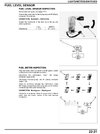Robbo
New Member
Hi have a 2015 nc750x with 60, 000 miles on clock.
Have an issue with fuel gauge.
On 2 bars starts flashing to fill up but has still 3 litres in tank.
Recently when it gets down to 2bars will not start as if no fuel, fill up and its starts ok. Any ideas
Cheers Dave
Have an issue with fuel gauge.
On 2 bars starts flashing to fill up but has still 3 litres in tank.
Recently when it gets down to 2bars will not start as if no fuel, fill up and its starts ok. Any ideas
Cheers Dave



